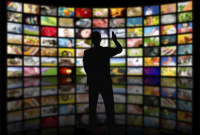 A couple of you have written me recently to say that you have already dropped cable TV or that you’re thinking about it. It’s something I think about regularly. For now I’m satisfied with our current plan. We have a very simple TV package (no ESPN) with a very nice Internet package (120/10Mbps.) If we dropped the TV part, we’d pay almost the same amount since we’d have un-bundled Internet. I know it’s a scam to keep their TV subscription numbers high but I’ll take it. But if you’ve decided that dropping TV might save you some money, here are some things to help you plan the transition:
A couple of you have written me recently to say that you have already dropped cable TV or that you’re thinking about it. It’s something I think about regularly. For now I’m satisfied with our current plan. We have a very simple TV package (no ESPN) with a very nice Internet package (120/10Mbps.) If we dropped the TV part, we’d pay almost the same amount since we’d have un-bundled Internet. I know it’s a scam to keep their TV subscription numbers high but I’ll take it. But if you’ve decided that dropping TV might save you some money, here are some things to help you plan the transition:
- Educate yourself! There’s a great (short) guide to cord cutting from Tom Merritt available on Amazon. If you’re a Prime subscriber, it’s currently free. Otherwise it’s a whopping $0.99. In fact, that’s probably all you need. Go read that book and ignore the rest of this post.
- If you like podcasts, check out http://www.cordkillers.com. Tom Merritt and Brian Brushwood host a weekly show about how to watch the TV you want, whenever you want, on whatever device you want. This is great no matter how you consume your content.
- How do you like to watch TV? Do you have to keep up with the latest episodes as soon as they come out? If so, make a list of all the shows that fall into this bucket and start adding up $2/episode which is about what it will cost to buy them. I’ve found that my viewing habits have changed dramatically and I’m not keeping up with current TV very much. I greatly prefer to wait until the season (or even the series) is over, wait for it to show up on Netflix or Amazon and then watch it all at once. Shows are a lot more enjoyable for me this way.
- Do you need any live events? Sports is probably the most common example. If yes, then you’ll need to figure out how to watch them. Maybe it means getting a basic cable package for the months when your sport is on. Or maybe your sport offers a package to stream games online. DirectTV has an online-only package like this for the NFL.
- If you still want to have the experience of fliipping on random live TV, two great options are SlingTV and Playstation Vue. Think of these services as old school cable except it’s delivered over the Internet. The caveats are that you’ll need to make sure they work with your devices and sometimes DVR-style features are limited to certain shows/channels. I expect to see a LOT more players in this market space in the next year or two.
- Pure streaming is a great solution, but if you’re willing to mess with some hardware and if you can get a good broadcast TV signal at your house, then you can pick up an antenna and some kind of little DVR box like a Tivo Roamio. Check out antennaweb.org for help picking an antenna and pointing it in the right direction.
If all that looks like too much work, here is my short recommendation:
- If you already have Amazon Prime, start with their video service. You might also want to add Netflix. Want ESPN? Get SlingTV. And if there are specific TV shows that still aren’t covered, then you’ll either need to buy the seasons individually or maybe Hulu will meet your needs. Remember that cutting the cord isn’t necessarily cheaper. The nice thing is that you can have more control over your spending. For example, you can turn these services on and off every month depending on what you’re watching.
- On the device front, I recommend a Roku. They have multiple versions for under $100 and they support almost every video service on the planet (Playstation Vue is the only notable exception I’m aware of.) If you already have an Xbox One or a Playstation 4, those make pretty good streaming devices but they don’t support as many apps as Roku. The Amazon Fire TV is also a great device.
Cutting your cable cord gets easier every month so even if you investigate this now and decide it’s not for you, check back again periodically to see how the world has changed.
